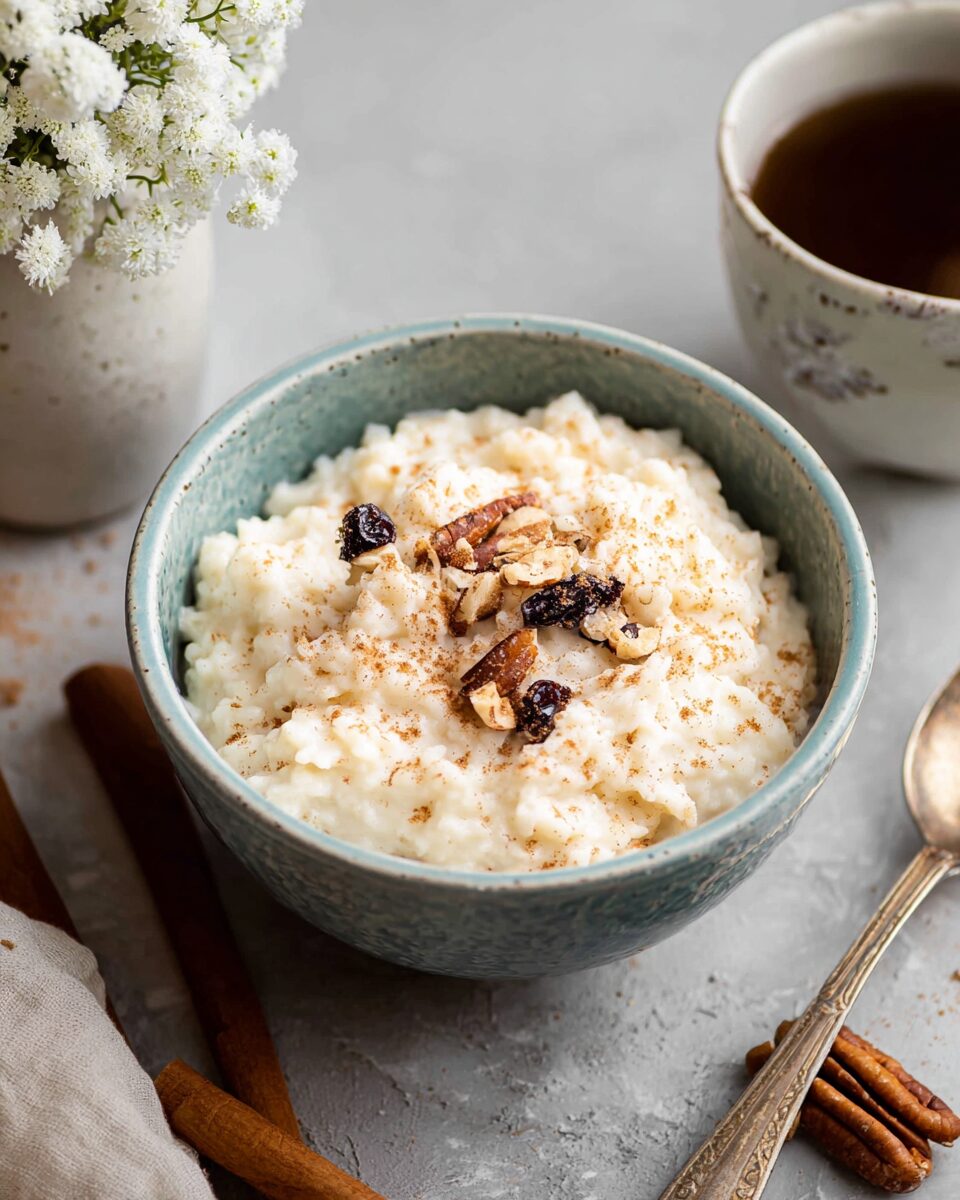Rice pudding has always been a comforting dessert, evoking feelings of cozy evenings and childhood kitchens. The combination of tender rice, creamy milk, and fragrant vanilla creates a rich, smooth texture that’s simply irresistible.
This dish is incredibly versatile and can be served warm or chilled, making it the perfect treat no matter the season. The gentle cinnamon swirl adds a delightful touch of spice and color, making it even more appealing. With just a few basic ingredients, this easy-to-make dessert will quickly become a household favorite for its comforting and satisfying qualities.
Full Recipe:
-
1 cup white rice
-
2 ½ cups whole milk
-
½ cup heavy cream
-
1/3 cup granulated sugar
-
1 teaspoon vanilla extract
-
1 cinnamon stick
-
Pinch of salt
-
Ground cinnamon (for garnish)
Directions:
-
Rinse the rice in a fine-mesh strainer under cold water until the water runs clear.
-
In a medium saucepan, combine the rice, milk, heavy cream, sugar, vanilla extract, cinnamon stick, and salt. Bring the mixture to a boil over medium heat.
-
Once boiling, reduce the heat to low and simmer, uncovered, for 20-25 minutes, or until the rice is tender and the pudding thickens. Stir occasionally to prevent the rice from sticking.
-
Remove the cinnamon stick and discard. Serve the rice pudding warm or chilled, garnished with a sprinkle of ground cinnamon.
Prep Time: 5 minutes | Cooking Time: 25 minutes | Total Time: 30 minutes
Kcal: 215 kcal | Servings: 4 servings
Recipe Overview
Rice pudding is one of those dishes that conjures up feelings of comfort and nostalgia. This creamy, slightly sweet dessert is made by simmering rice in milk or a combination of milk and cream, creating a velvety texture that melts in your mouth. Rice pudding can be enjoyed warm on a chilly evening or chilled during the summer months, making it a versatile treat perfect for any occasion. It’s simple to prepare, yet it can be elevated with different flavors and toppings to suit your taste. Whether you like it plain or with a touch of cinnamon, raisins, or a dollop of whipped cream, rice pudding remains a beloved classic in many households.
History and Origin
Rice pudding has a rich history that spans many cultures, with variations found across the globe. This dish can trace its origins back to ancient times. In fact, versions of rice pudding were enjoyed in ancient Roman and medieval European kitchens, where rice was considered a luxury ingredient. It is believed that rice pudding made its way to Europe through the trade routes, where it became a popular comfort food. In the Middle Ages, rice was prized not just for its sustenance but also for its ability to be turned into a dessert.
In the United States, rice pudding gained popularity in the 19th century, especially as rice became more widely available due to agricultural advancements in the South. The dish’s ability to feed a family with minimal ingredients made it a staple in many households. Over time, different regions have put their spin on rice pudding. For example, in the United Kingdom, rice pudding is often made with a generous portion of milk, while in Asia, the use of coconut milk and a variety of spices adds unique flavors to the dish.
Variations and Adaptations
The beauty of rice pudding is in its adaptability. Each culture has its own version of this humble dessert, often reflecting local ingredients and tastes.
-
Classic American Rice Pudding: Often made with short-grain rice, whole milk, and sugar, this version is the quintessential comfort food. It is creamy and sweet, with hints of cinnamon or nutmeg to add warmth. Some variations include raisins or other dried fruits for added texture and flavor.
-
Arroz con Leche (Latin American Rice Pudding): A staple in many Latin American countries, arroz con leche typically incorporates cinnamon sticks, vanilla, and orange zest. It’s usually made with condensed milk, which gives it a rich, dense consistency. In some countries, the pudding is topped with coconut or sprinkled with powdered sugar.
-
Indian Kheer: In India, rice pudding takes the form of kheer, a dish spiced with cardamom, saffron, and sometimes rose water. The use of nuts like almonds or cashews, and the addition of sweetened condensed milk, gives kheer a unique, indulgent flavor profile.
-
Middle Eastern Rice Pudding: In parts of the Middle East, rice pudding is known as roz bel laban and is often flavored with orange blossom water or rose water. It is also common to garnish the pudding with crushed pistachios or a drizzle of honey for added richness.
-
Vegan Rice Pudding: For those looking for a dairy-free alternative, rice pudding can easily be adapted. Coconut milk or almond milk are popular substitutions for regular milk, and maple syrup can replace sugar for a healthier touch. The result is a creamy, vegan-friendly dessert that’s just as satisfying.
Nutritional Information
Rice pudding can be a comforting dessert, but like many indulgent dishes, it’s important to be mindful of its nutritional content. The traditional version, made with whole milk and sugar, can be relatively high in calories and sugar. Here’s an approximate breakdown of the nutritional values in one serving (based on a standard recipe with whole milk and sugar):
-
Calories: 215 kcal
-
Carbohydrates: 38 grams
-
Protein: 5 grams
-
Fat: 5 grams
-
Fiber: 1 gram
-
Sugar: 19 grams
-
Sodium: 60 milligrams
While it’s a relatively calorie-dense dessert, rice pudding also contains a good amount of calcium and vitamin D (thanks to the milk), making it a satisfying way to enjoy some essential nutrients. If you’re aiming for a healthier version, you can use low-fat or plant-based milks to reduce the fat content. Substituting sugar with natural sweeteners like stevia or honey can also make the dish a bit lighter.
Serving Suggestions and Pairings
Rice pudding is a versatile dessert that can be served in various ways, depending on your preference and the occasion. Here are a few creative ideas for serving rice pudding:
-
Garnish with Cinnamon and Raisins: A sprinkle of ground cinnamon or cinnamon sugar on top of your rice pudding will elevate its flavor and aroma. Add raisins or dried cranberries for a burst of sweetness and texture.
-
Fruit Compote: For a fresh twist, top your rice pudding with a berry compote or a mix of seasonal fruits like mango, peaches, or strawberries. The tartness of the fruit pairs beautifully with the creaminess of the pudding.
-
Topped with Nuts: Chopped almonds, pistachios, or pecans can add a satisfying crunch. Their nuttiness also contrasts nicely with the soft rice.
-
With a Drizzle of Caramel or Honey: A drizzle of warm caramel sauce or honey adds extra sweetness and richness, making the pudding feel even more decadent.
For pairing, rice pudding goes wonderfully with a cup of hot tea or coffee. The warmth of the beverage complements the creamy texture of the pudding. If you’re serving it for dessert after a meal, consider pairing it with a light, fresh salad or grilled meats, as rice pudding’s sweetness will balance savory dishes.
Tips and Tricks for Success
-
Use Short-Grain Rice: Short-grain rice (like Arborio rice) is perfect for rice pudding because it releases more starch, making the pudding creamier. If you’re using long-grain rice, the pudding may turn out less creamy.
-
Stir Often: Stirring occasionally as the rice cooks helps prevent it from sticking to the bottom of the pan. This also ensures that the pudding becomes nice and creamy.
-
Watch the Heat: Cooking the rice pudding on low heat is key. High heat can cause the milk to scorch or the rice to overcook. Patience is important, so take your time!
-
Add Flavorings Early: For the best flavor, add your spices (such as cinnamon or cardamom) early in the cooking process. This allows the flavors to infuse into the pudding as it simmers.
-
Serve Warm or Chilled: While rice pudding can be served immediately, it often tastes better after it’s had time to chill. The flavors meld together beautifully when refrigerated for a few hours.
Potential Health Benefits
Though rice pudding is generally considered a treat, it does offer a few health benefits due to the ingredients used. Here are some potential advantages of incorporating this dish into your diet:
-
Rich in Calcium: If made with milk, rice pudding is a great source of calcium, which supports strong bones and teeth.
-
Energy Boosting: The carbohydrates in rice provide a quick energy boost, making it a filling dessert that can be satisfying after a long day or before a workout.
-
Contains Protein: The milk and rice provide a decent amount of protein, which is important for muscle repair and immune function.
-
Customizable to Health Needs: By swapping ingredients like whole milk for almond or coconut milk and reducing sugar content, rice pudding can be adapted to fit dietary preferences, including vegan, gluten-free, and lower-calorie needs.
Conclusion
Rice pudding is a timeless dessert that transcends cultures and generations. Its versatility allows for endless variations, from traditional American recipes to exotic versions with spices and fruits. Whether you enjoy it warm on a cold evening or chilled as a refreshing treat, rice pudding is sure to please everyone at the table. So, next time you’re in the mood for something comforting and indulgent, make this classic dessert and share it with your loved ones. It’s simple, satisfying, and oh-so-delicious!





